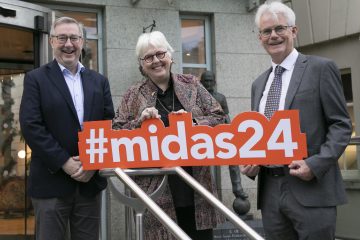Microelectronics Industry in Ireland
www.midasireland.ie
John Blake
MIDAS Ireland Chairman 2013
May 15th 2013
During the past almost four decades, a world-class microelectronics industry has developed in Ireland, There are about 50 companies in the sector, with a healthy mix of leading multi-nationals like Intel, Analog Devices & Xilinx, as well as a growing number of indigenous companies like S3 Group, Movidius, Redmere & Powervation.
The global microelectronics market is worth $300B annually, and this is forecast to continue growing well into the future.
Microelectronics is an enabling industry. Sometimes we take this for granted or even forget it. Right across the spectrum from consumer electronics products such as the Apple iPhone in your pocket, to green energy wind turbines that supply an ever increasing 30%+ of electric power to our homes, to energy aware data centers that will power the next generation cloud computing infrastructure, a whole raft of microelectronic products and devices are to be found. Microelectronic products are used in many other industries including IT, telecommunications, medical devices, automotive, etc, and enable over $7.9 Trillion worth of electronic products each year.
A core focus of the microelectronics industry in Ireland is on the design of these microelectronic products which are commonly known as integrated circuits (IC). ICs are the key technology components in electronic systems today and the point at which much innovation takes place. As the underlying semiconductor technology evolves and achieves increased performance, new and exciting applications for the integrated circuit come along, so innovation through new products is an ongoing cycle that must be supported on a continual basis.
For the past 40 years, Moore’s Law has described the pace of innovation. In accordance with Moore’s Law, every eighteen months the speed of our computer processors doubles. Integrated circuit technology has evolved at such a staggering pace that the processor in our smart phones is now more powerful than its counterpart in the desktop computers that became widespread in the early 1990’s.
The microelectronics industry in Ireland can be traced back to the arrival of Analog Devices to Limerick in the mid 1970’s. During the past 35 years, as the size of and experience of our engineering community has grown, a steady stream of major multinationals have arrived on our shores, including Intel, Xilinx, Cypress, Texas Instruments, Maxim and ON Semiconductor. Numerous home grown start-ups have emerged and today these number close to 30, the majority having their primary focus on integrated circuit design and product development. This design activity also promotes and creates significant indirect employment in supporting disciplines such as manufacturing, supply chain and support services.
The design activity adds up to about €200M that is spent annually by companies on microelectronic circuit design & product development in Ireland, which is a significant percentage of the overall R&D expenditure by businesses across all sectors of the economy.
The quality of the R&D and products developed are world class and can be seen by the adoption rates achieved by these products in the worldwide microelectronics market. This quality is also evident through patents & technical publications. Searching the US Patent Office database, close to 5,000 patents were granted since 1975 to Inventors having addresses in Ireland. Over 10% of these of these patents came from the microelectronics sector.
The industry is doing very well on innovation and importantly in jobs growth with significant announcements during the couple of years from companies like Intel, Analog Devices, Microsemi, ON Semiconductor, Hittite, M/A-Com Technologies and ZMDI, which are further votes of confidence in the industry, and in Ireland as a location to do business.
Start-ups in the sector are well recognized globally, as is evidenced by the products and technology they develop, the amount of venture capital money that is being invested, and M&A activity.
This all adds up to a world class microelectronics industry in Ireland with a leadership position in the area of mixed-signal IC design. Ongoing and active support for building the R&D capability from the Irish state agencies, IDA, Enterprise Ireland & Science Foundation Ireland has been central in achieving this.
MIDAS Ireland (Microelectronics Industry Design Association – www.midasireland.ie ) is the industry led partnership consisting of microelectronics companies, educational / research institutions and government agencies working together to promote and support growth across the microelectronics sector in Ireland.
MIDAS estimates that total employment today is about 8,000 and the sector contributes around €6 Billion annually to Irish exports, which of course also contributes significantly to the EU’s trade with the rest of the world. 25%, or 2,000, of these jobs are in high added value knowledge intensive R&D positions.
As is evidenced by recent sector announcements, the industry is poised for further significant growth over the next decade and MIDAS is focused on ensuring the necessary support is in place to make this growth a reality. This growth is expected to translate into hundreds of new R&D jobs being created every year, both for experienced and graduate level engineering positions.
MIDAS is working closely with the Irish third level sector as one of its highest priorities to ensure there is a plentiful supply of excellent electronic engineering graduates to fill the engineering positions as they come available, and is also sending out the message to engineering students, second level students and their parents that this industry is hiring and open for business. The industry provides exciting, challenging and rewarding careers creating products and technologies that have significant positive impact on how we live and on our environment, and engineering generally is a very valuable education, with a wide variety of career options open to graduates.
The indigenous sector is fueled by start-ups. A start-up in our sector faces many unique challenges both of a technical and business nature. On the technical front, access to electronic design automation (EDA) software and semiconductor manufacturing foundries to build the initial prototypes is absolutely essential. Access to VC money and to market and business knowledge is also a critical gateway to growth. MIDAS is working with the state agencies in Ireland on a specific start-up initiative to address these unique challenges and ensure the supports are in place in the long term.
Research is another key area to ensure new technology capabilities and advanced skillsets are developed on a continual basis and align with the industry needs. MIDAS works with the government agencies on research policy and is also working with the research providers to support the growth in numbers of integrated circuit design researchers working in our third level colleges.
In conclusion, there is a very bright future and growth opportunities for the microelectronics industry in Ireland, and the industry wants to actively work with state agencies, research funders and providers, the educational sector and government, in ensuring the infrastructure is in place to support this growth, so we may capitalize fully on the opportunities that exist for the mutual benefit of all.

